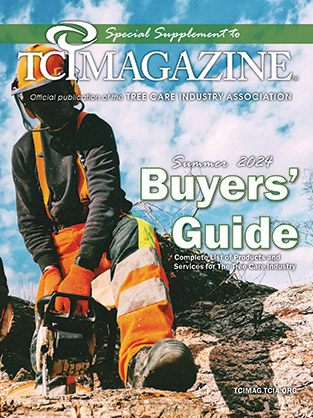Sales Tools in Arboriculture: The Second-Most Important Tool
We may be living in the “Golden Age of Arbor Care!” Both science and technology have advanced to new levels – new tree cultivars and hybrids, and new exotic pests and diseases that keep cropping up. And we are dealing with them all.
There is an elevated interest in our society for “green living,” and that is advancing the valuation of trees for both individual properties and whole communities. For many tree care companies, it is the elevation of marketplace greenness and current expansive construction activity that is elevating sales.
Most commercial arborists are seeing sales reach new heights, just because there are more green-minded people who have more disposable income. Transaction volumes and contract values are at all-time highs.
If yours aren’t, why not?
- For some, the answer is simply regionality. The demographics are changing negatively.
- For some, it is macroeconomics. The advancing recession has hit them harder.
- For some, it is resources. There just aren’t enough qualified workers, thus, less work gets done and your cash flow has dropped.
- For some, it is a function of one’s market position. (You are judged by those who purchase tree care, both individuals and the overall, aggregate marketplace.)
- For some, you believe being cheaper, “taking the easier road,” is your way. (In a tone as clearly as possible, let me declare, “Price is only a consideration when value is not perceived!”)
All five points relate to all of us on some level, or in a different priority!
Point 3 is becoming more of a reality in the green industry! But it is to points 4 and 5 that I wish to speak in this article.
In my previous and related article, “The #1 Sales Tool in Arboriculture” (TCI, November 2022), my premise, summed up, was this: First impression, in a business meeting, is a major, positive and direct influencer in the buying decision. This is especially true when you are the only business-card presenter in a sales event! But how does one elevate and advance the image of the company? How can one present one’s operation beyond a small business card?
There is a second tool that will increase your closing percentage by influencing potential customers in their buying decision. This tool will sway the opinion of tree care buyers, particularly those who value professionalism and technical competency. These potential buyers are the ones who, when convinced and impressed, will pay a premium. And, more important, they become repeat clients.
Before revealing this tool, let’s consider a fundamental aspect of tree care sales. It is, at least in part, humorous when we say, “Tree doctors make house calls.” We must see the tree in person, to specify and price the work. And most times, the tree owner is not home. There is no personal connection, and the opportunity for a face-to-face values statement does not exist.
It is here where the second tool, a Corporate Introduction Statement, does its work. It should be used with every work quote – handwritten or computer generated, mailed or left in the doorway.
What it should say:
- “This is who we are.” Briefly, tell your story. If a new company, why did you start? If a veteran business, talk about stability.
- A family business? Tell them who is who. A generational company? Share about dad or grandpa. And how the company holds on to the legacy.
- Talk about your passion for trees (if you are passionate). Reveal how work is conducted.
If a single-crew company, share that you oversee every job when completed.
If a multiple-crew company, talk about the collective years of experience.
If a large company, talk about commitment to excellence, company-wide training.
And, more important, for every company:
- What is the one thing you want every client/customer to know about the company?
- What one testimony should every future customer hear from one of your existing clients?
- Is there one story that highlights your corporate values?
My example: In the 20th-anniversary edition of our company’s corporate-intro newsletter, I shared a brief story of my granddaughter joining me on a tree-preservation project. We were systemically fertilizing the targeted trees on the site. She carried my drill.
In my story, I recounted that question asked by my 7-year-old little girl.
Granddaughter: “G’pa, what are we doing?”
Grandpa: “We’re giving the trees ‘a shot’ to make them grow better. I am the Tree Doctor.”
After a bit of time, she looked to me and, with great seriousness, said, “Well, that makes me the tree nurse.”
“Yes, sweetie, you are the best Tree Nurse.”
I received more comments on this story, from new and existing clients, than from all our other communications combined! And many of the remarks came to us with orders for services!
People today will assume you know something about trees. If you’re a Certified Arborist or TRAQ credentialed, the alphabet behind your name is important, and telling. But as a selling arborist, what people want is a professional who is knowledgeable, experienced and trustworthy.
The Corporate Introduction Statement will advance that consideration!
Trust is a value earned or lost. Trust comes from the execution of our duties, faithfully. Trust can grow over time, and it is trust that is the prime condition to generate referrals.
Trust is generated by performance over time; it is the genesis of reputation. In an industry where we all focus on gear and equipment, it is not the bigger chipper or the taller boom that makes you more money.
The trees are not your clients, the tree owners are! And building trust is putting money in the bank.In this “Internet Age,” your website is your 21st-century storefront. Your email address is akin to the 1960s or ’70s business phone. Yet, the website is a docile statement – the tree owner must be looking for it. Many will only wait a few seconds for it to boot up, and most only spend a minute or two looking it over. Some will use it as a first-contact tool. They also will contact other companies through their websites!
However, in an age of a massive volume of email, social-media posts and “unlimited” search results, your Corporate Intro Statement, professionally prepared, given with each work quote (along with a business card), becomes your statement of success, competency and trustworthiness. It will be read. It is far more active, current and motivating than any website.
In using Tool #2, your company will be leveraged forward for prime consideration in client procurement and the purchasing of tree care services.
Jeffrey Ling is a Registered Consulting Arborist operating as Arborwise, Ltd., and is the retired co-owner of TreeMasters Inc., a former 11-year TCIA member tree care company based in Fort Wayne, Indiana. He has 38 years of commercial arboriculture experience and more than 50 years in business management.




